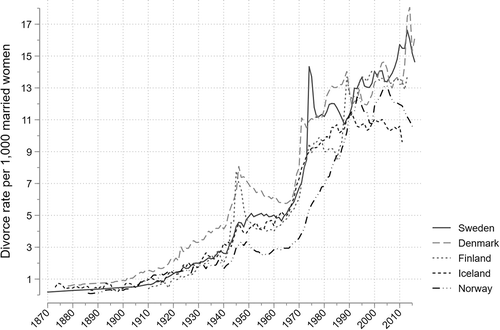Figures & data
FIGURE 1 Divorce rate per 1,000 married women in the Nordic countries 1870 − 2016.
Sources: Denmark: On the number of divorces: For the period 1878 − 1900: Müller, Om adgang til skilsmisse, p. 124. For the period 1901 − 1916: Statistics Denmark, ‘HISB3. Nøgletal om befolkningen‘. On population figures (at 5 − 10 years intervals): Statistics Denmark, ‘Folketællninger‘. Finland: Nieminen. Väestötilastoja 250 vuotta. Väestö 1999:8. Helsinki: Tilastokeskus, 59 − 62; Pitkänen and Jalovaara, ‚Perheet ja perheenmuodostus‘; Statistics Finland. Befolkningsförändringar 2014. Helsinki: Tilastokeskus – Statistikcentralen – Statistics Finland, Citation2016, 160. Iceland, For the period 1873 − 1903: see Björnsdóttir, ‘Ég vil heldur skilja‘. For the period 1904 − 1990: Hagskinna, table 2.33. For the period 1991 − 2011 see: Statistics Iceland, ‘Marriages dissolved and judicial separations 1951 − 2011‘.Norway: Mamelund, et al., Divorce in Norway 1886 − 1995 by calendar year and marriage cohort. Statistics Norway, ‘Tabell: 09660: Ekteskap og skilsmisser‘and ‘Tabell: 05813: Folkemengde, etter kjønn og sivilstand‘. Sweden: Statistics Sweden. Befolkningsutveckling; födda, döda, in- och utvandring, gifta, skilda 1749–2016‘; ‘Befolkningsrörelsen 1911 − 1966‘; ‘Befolkningsförändringar 1967 − 1992‘; ‚Befolkningsstatistik del 3‘, 2001, 14. Note: The number of divorces per year is available for all the countries from the late 19th century. For the period prior to modern computer-based population registers (−1960s), the number of married women has been determined from the censuses available at five- to ten-year intervals. The yearly population at risk used as the denominator for the divorce rate has then been estimated through linear interpolation for the years between two censuses. The exception to this is Sweden, which has continuous records for the married population going back to the 19th century.

